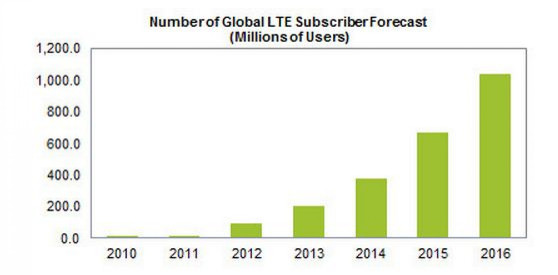Global LTE Subscribers To Exceed 198 Million In 2013
The number of worldwide subscribers of the 4G wireless standard known as the Long Term Evolution (LTE) is expected to exceed the 100-million mark in 2013, according to a new IHS iSuppli report.
As per the report, the global LTE subscribers will reach 198.1 million in 2013, up 115 percent from 92.3 million last year. Adopted in 2010 with just 6,12,000 users, the user base of the 4G next-generation wireless technology has increased to 13.2 million subscribers in 2011 and then jumped 599 percent in 2012 to nearly 100 million subscribers.
The report added that by 2016, LTE would claim over 1 billion users, as shown in the figure below, equivalent to a five-year compound annual growth rate of 139 percent.

“With LTE emerging as a true global technology standard, its ecosystem now faces both challenges and opportunities,” said Wayne Lam, senior analyst for wireless communications at IHS. “Rapid adoption will drive design innovations, particularly in smartphones, but issues like spectrum fragmentation will also remain an overhang for the LTE industry that requires attention.”
“Overall, however, the LTE space will be less worried about rifts or divisions in technology, and more concerned with laying the foundation for sustained growth across the entire LTE landscape,” said Lam.
According to IHS iSuppli, wireless network operators have been incessantly building the infrastructure for LTE technology globally. The factors that have been contributing to this development include increased appetite among the consumers for faster content delivery, feature-rich applications and expansive mobile services such as social networking. The majority of growth during the last couple of years came from smartphone upgrades, especially as 4G LTE technology hit top-of-mind for data-savvy consumers.
However, although LTE has become the de facto global standard for 4G over WiMAX, an early rival, interoperability across multiple carriers and spectrum holdings is far from consistent.
“While the precursor 3G technology was deployed over a handful of spectrum bands globally, LTE so far has registered more than 40 different frequency spectrums, resulting in a complex landscape for equipment and component suppliers,” said the report.
But despite this difficulty, the report opined that the advantages to be derived from LTE were nonetheless substantial. Compared to the preceding cellular standards, LTE with its low-latency performance allows the handling of a wider range of applications, for example live video streaming, video conferencing, voice over IP and real-time multiplayer gaming. These new applications, in turn, create fresh market opportunities for component supplier and device manufacturers.
© Copyright IBTimes 2025. All rights reserved.





















